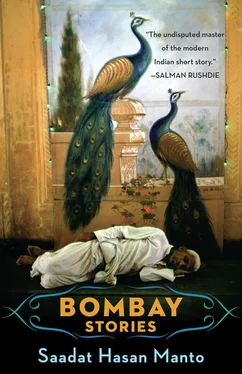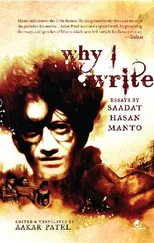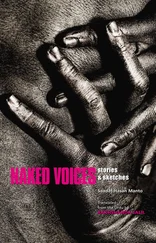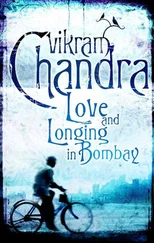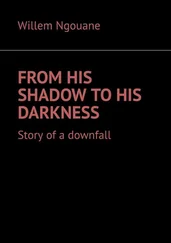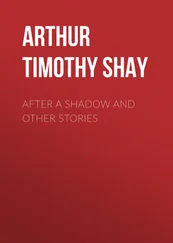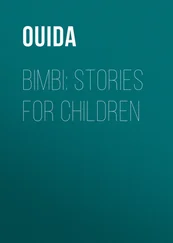Manto never compiled all his stories set in Bombay in one volume, so this collection of translations is both a sample of his work and represents a specific aspect of it. I have organized the stories chronologically. In fact he wrote the bulk of them after immigrating to Pakistan (eleven of the total fifteen), and this retrospective attention appears prominently in several stories. For instance, in ‘Mammad Bhai’ he writes, ‘It was almost twenty years ago that I used to frequent those restaurants’; and in describing the title character, ‘I don’t remember what exactly he looked like, but after so many years I can still recall anticipating that he must be enormous, the kind of man Hercules bicycles would use as a model in their advertising.’ Most of these stories were apparently written, at least in part, to assuage the pangs of nostalgia.
Lastly, if Manto is indeed the first representative of the contemporary Indian genre, then we might also consider how his prose includes literary devices that we now characterize as post-modern. Many of these stories feature narrative irruptions and self-reflexive commentary; he also obfuscates the clean genre limits of biography and fiction. While most writers of fiction covertly include details from their lives, Manto goes further, and in many stories he incorporates an eponymous Manto character — a character that roughly corresponds to the actual man. There are seven such stories in Bombay Stories , and practically every story in which his character appears does, in fact, give us some detail that is true to his life. In ‘Babu Gopi Nath’, we find the character, Manto, working at a weekly newspaper in Bombay, just as the actual Manto did. In ‘Janaki’ we find him writing film scripts. In ‘Mammad Bhai’ he falls ill with malaria while living in a tiny room. ‘Rude’ tells us how he spent time working in Delhi, as well as revealing his fascination with the Communist Party. In ‘Barren’ he talks about how he would earn seven to ten rupees for each story he wrote, and in ‘Mummy’ he mentions the death of his son. While each story provides us with some accurate biographical information, other details are blatantly inaccurate. ‘Rude’ provides us with the best examples. In this story Manto is re-acquainted with a character named Nasir, an old friend from Aligarh Muslim University. Manto did reunite with an old friend after returning from his hiatus in Delhi, but this was Shahid Latif. Also we notice that Nasir is a foreman in a factory and husband to the famous Communist leader Izzat Jahan, and Shahid Latif was married to the writer Ismat Chughtai and worked in the film industry.
Authorial intrusions also complicate stories — especially those with an eponymous Manto character — as they highlight the stories’ constructed and textual nature, often in a disingenuous or misleading way. In ‘Siraj’ and ‘Barren’, two stories that use an autobiographical conceit, Manto refers without prompting or an obvious narrative reason to the fact of his writing. Relevant passages in ‘Siraj’ are the following:
But this is the impression of a short story writer who in describing a tiny facial mole can make it seem as large as the sang-e-aswad in Mecca.
These details are enough. I don’t want to tell you what I thought because it’s not relevant to the story.
The city had built tin shacks there for the poor, and I won’t mention the nearby high-rises because they have nothing to do with this story, only that in this world there will always be the rich and the poor.
I don’t want to get into the details, but Siraj was with me at a hotel.
And from ‘Barren’:
Anyway, enough of this. If I go on in such detail, I’ll fill page after page and the story will get boring.
But now I’ve started talking about my stories!
By bringing attention to his authorial consciousness, Manto focuses our attention briefly on exactly what he pretends to dismiss or belittle: ‘Siraj’ is about storytelling (both Manto’s and Dhundhu’s), and it is about the rich and the poor, just as ‘Barren’ is about the exchange of stories and lies between Manto and Naim. Perhaps in ‘Barren’ we have an analogy that explains Manto’s fact-befuddling style: Naim writes to Manto at the story’s end to confess that he made everything up, and yet he also avers that while objectively false, his stories felt true, and that through his lies he expressed a real part of himself. As self-conscious reflections on storytelling interrupt the authorial transparency of documentary realism, we see a style emerge that makes Manto progressive in a sense separate from what the term meant during his lifetime: he had outstripped the literary conventions of his time.
Matt Reeck
1 Wadhawan, Jagdish Chander. Manto Naama: The Life of Saadat Hasan Manto . Trans. Jai Ratan. New Delhi: Roli, 1998, 14.
2 His family migrated into the Indian plains at some point near the beginning of the nineteenth century (Wadhawan, 13).
3 Flemming, Leslie A. Another Lonely Voice . Berkeley, CA: Center for South and Southeast Asia Studies, UC Berkeley, 1979, 4. Or Hasan, Khalid. ‘Saadat Hasan Manto: Not of Blessed Memory.’ Annual of Urdu Studies 4, (1984): 85.
4 Hasan, 85–95.
5 Manto, Saadat Hasan. ‘Pundit Manto’s First Letter to Pundit Nehru (That Has Become the Foreword to a Novel)’ [ ‘Pandit nehru ke nam pandit manto ka pahla khat (jo is kitab ka dibachah ban gaya)’ ] . Untitled. (Baghair unwan ke.) Lahore: Zafar Brothers, 1956. Republished in Manto Baqiyat . Lahore: Sang-e-Meel, 2004. 411.
6 Flemming, 2.
7 Ibid., 2.
8 Ibid., 14.
9 Ibid., 3.
10 Manto, Saadat Hasan. ‘Two Encounters with Agha Hashr’. (‘Agha hashr se do mulaqaten’.) Bald Angels. (Ganje farishte.) Lahore: Gosha-e-Abad, 1955. Re-published in Mantonuma . Lahore: Sang-e-Meel, 2003, 31.
11 Flemming, 2.
12 Ibid., 4.
13 Ibid., 4.
14 Ibid., 4.
15 Ibid., 3.
16 In Urdu, ‘Musawat’ .
17 Hugo’s Le dernier jour d’un condamné was first published in 1829. The fourth edition, published in 1832, was prefaced by a short drama, which served as Hugo’s literary response to the criticism and controversy the novella had elicited. Manto translated both the dramatic foreword and the novella.
18 Wadhawan writes that Manto finished translating Hugo’s novella in a mere fifteen days. Were this true, Manto’s effort here would be characteristic of the fast work rate he demonstrated later. But Wadhawan does not cite any sources for us to verify whether this detail is factual or rather, stands as another example of how literary scholars have mythologized Manto as a sort of enfant terrible and Romantic genius. For an interesting look at how Manto has been used by literary scholars both in America and in South Asia, read Richard Delacy’s ‘Sa’adat Hasan Manto: The Making of an Urdu Literary Icon’. MA Thesis. Monash University (Clayton, Australia), 1998.
19 See ‘Bari Sahib’. Bald Angels . Re-published in Mantonuma , 71.
20 Vera, or the Nihilists , Wilde’s first play, was first produced in New York in 1882.
21 Wadhawan suggests that Manto knew Russian, French, and English but does not provide evidence to corroborate this ( Manto Naama , 178). Alain Désoulières writes that Manto translated the Russian and French texts through English translations (‘Vie et œuvre de Saadat Hasan Manto (1912–55).’ Toba Tek Singh et autres nouvelles , Saadat Hasan Manto. Trans. Alain Désoulières. Paris: Buchet-Chastel, 2008, 11–12.) Lastly, in his essay ‘Babu Rao Patel’, Manto confesses that his English was mediocre: while it was good enough for basic comprehension, he found translating the English of Babu Rao Patel, the editor of a Bombay magazine Film India , very difficult (‘Bari Sahib’, 213).
Читать дальше
